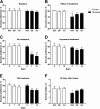The neuronal insulin sensitizer dicholine succinate reduces stress-induced depressive traits and memory deficit: possible role of insulin-like growth factor 2
- PMID: 22989159
- PMCID: PMC3564824
- DOI: 10.1186/1471-2202-13-110
The neuronal insulin sensitizer dicholine succinate reduces stress-induced depressive traits and memory deficit: possible role of insulin-like growth factor 2
Abstract
Background: A number of epidemiological studies have established a link between insulin resistance and the prevalence of depression. The occurrence of depression was found to precede the onset of diabetes and was hypothesized to be associated with inherited inter-related insufficiency of the peripheral and central insulin receptors. Recently, dicholine succinate, a sensitizer of the neuronal insulin receptor, was shown to stimulate insulin-dependent H2O2 production of the mitochondrial respiratory chain leading to an enhancement of insulin receptor autophosphorylation in neurons. As such, this mechanism can be a novel target for the elevation of insulin signaling.
Results: Administration of DS (25 mg/kg/day, intraperitoneal) in CD1 mice for 7 days prior to the onset of stress procedure, diminished manifestations of anhedonia defined in a sucrose test and behavioral despair in the forced swim test. Treatment with dicholine succinate reduced the anxiety scores of stressed mice in the dark/light box paradigm, precluded stress-induced decreases of long-term contextual memory in the step-down avoidance test and hippocampal gene expression of IGF2.
Conclusions: Our data suggest that dicholine succinate has an antidepressant-like effect, which might be mediated via the up-regulation of hippocampal expression of IGF2, and implicate the neuronal insulin receptor in the pathogenesis of stress-induced depressive syndrome.
Figures





References
-
- Willis T. Diabetes: A Medical Odyssey. Tuckahoe, New York; 1971.
-
- Asghar S, Hussain A, Ali SM, Khan AK, Magnusson A. Prevalence of depression and diabetes: a population-based study from rural Bangladesh. Diabet Med. 2007;24:872–877. - PubMed
Publication types
MeSH terms
Substances
LinkOut - more resources
Full Text Sources
Other Literature Sources
Medical
Research Materials
Miscellaneous

